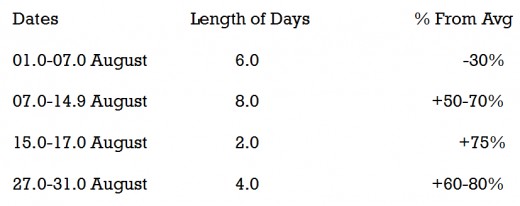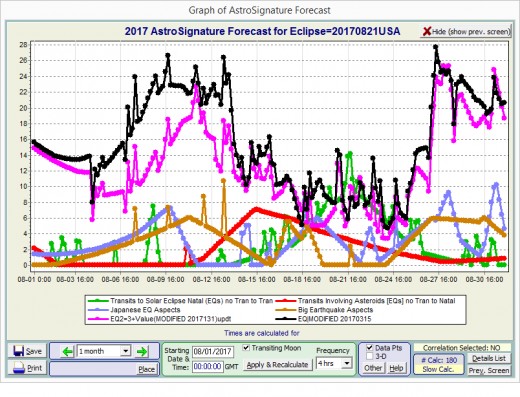Seismic Review and Forecast for August 2017


July Broke the Tension (A Large Earthquake at Last)
Technically, July 2017 was an average month. However, it marked a turning point in seismic activity for the largest of earthquakes, which had stalled beginning five to six months prior. For 176 days, there were no earthquakes of at least 7.1 magnitude when normally there is one such quake on average each month. What was not typical about this last month is that the quake that occurred in this size range released more than ten times the energy of the six earthquakes of 6.3 to 6.6 magnitude that also occurred or for those events of a level just beneath it in strength. In that regard it was not an average month, although it appears that way at first glance in the table given below.

Seismic Review of July 2017
The smallest of these quakes was a 6.3 magnitude event that was a foreshock to the 7.7 magnitude main shock in Russia (both separated by 12.5 hours). Within three hours following this very large shock, a magnitude 6.3-6.4 event occurred on the southern coast of Peru. An hour shy of three days after the 7.7 magnitude event, there was a 6.6 magnitude quake on the Turkey/Greece border. That happened to be in a popular tourist area and the two deaths caused by this quake were tourists.
There was also a phase of activity that occurred earlier in the month but, they were in the 6.4-6.6 magnitude range also. Those quakes occurred south of New Zealand, The Philippines, and in the Papua New Guinea area. That was during the 6th through the 13th of July. Both myself and another forecaster from the Netherlands thought that there would be an earthquake of at least 7.1 magnitude in July, which I thought could be as high as a 7.8 while he thought that it could reach the just over 8.0 magnitude level. I was right about the size but he was just barely right about the date; he expecting something on the 17th and me on the 18th of July, while it occurred during the last half hour of the 17th.
Many times earthquakes of at least 7.7 magnitude set off a temporary worldwide storm which can last anywhere from around ten days to as much as six weeks. I thought that that might happen this time too, but things fizzled out after the early activity following the largest quake of the month. Things would seem to have calmed down again after that very large but isolated event. And it might stay that way until after the 21 August 2017 total solar eclipse, although there are a couple of windows that open up before that.

Seismic Forecast for August 2017
One thing that I have learned from forecasting earthquakes in relation to the celestial heavens is that astrology does not perform well as a forecast mechanism when seismic activity is average or less. The exception for this would be for the largest earthquakes of at least 8 in magnitude (but perhaps as low as 7.7 in magnitude). For example, 1 April 1968 through 31 August 1968 was a very active period and astrological earthquake indicators accurately forecasted the timing of the occurrence of earthquakes of at least 7.1 magnitude during that time (75% of the time). On the other hand, during the year from the middle of 2016 to the middle of 2017, seismic activity was no better than average and astrology in its ability to forecast earthquakes was very limited or not as reliable during that time.
If one were to ask me how my forecast did for the last month, it has been about the same as it has been for the year before it; a bit mixed. I expect the forecasts to become more accurate following the August 2017 total solar eclipse. The reason for that is because I expect that eclipse, which is more seismically aligned than the average eclipse, should cause an upswing in significant activity (earthquakes of at least 6.7 in magnitude) which should in turn relate more to astrological indicators.
A rough estimate of possible locations would be in Indonesia or Japan in the middle of the month. Japan around the 9th or 10th or Japan and possibly the United States on or near the 28th of August. I expect seismic activity to be roughly average for August 2017, except perhaps for these three locations.
Final Notes
The reason why there was a delay getting this report out for this month was mainly because I was not in a hurry due to another project that I was working on and the lack of earthquake activity foreseen for the first few days of the month as reflected in the second table above.
For the first table shown above, the number of earthquakes for the ranges of 6.0 to 6.3 and 6.4 to 6.7 could be four quakes each. The reason for that is because, due to interference from seismographic readings of the 7.7-7.8 magnitude event of late on the 17th, the earthquake in Peru about 2.5 hours later was difficult to determine and it was decided by GCMT to put off determining its magnitude until more detailed reports arrived in September (the table assumes a magnitude of 6.4 for the Peru event but it could be 6.3).

This article is accurate and true to the best of the author’s knowledge. Content is for informational or entertainment purposes only and does not substitute for personal counsel or professional advice in business, financial, legal, or technical matters.
© 2017 Joseph Ritrovato








